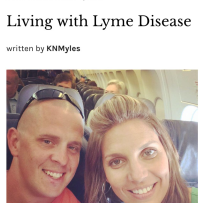Living with Lyme Disease

Living with Lyme Disease
The story shared below is a guest post from my friend Lauren. Lauren and I went to high school together, and before Brian and I moved our family to another town, Lauren and I would see each other fairly often. We would get together for playdates, or a night out with a few other friends of ours.
At that time, my life and work in the Ehlers-Danlos and chronic illness communities were not something that was often a topic of conversation with any of my friends, especially ones outside of the EDS and medical world. Most friends probably had some idea about what I do: that I worked for myself in medical sales, that I volunteered for the Ehlers-Danlos National Foundation (EDNF), and that I was working on another small business. However, when you do not have a chronic condition(s), it’s very hard to understand or relate to someone who does. And vice versa, when you do live with chronic illness, especially one that is “invisible,” you don’t always want your daily struggles to be the main topic of conversation or all that anyone asks or knows about either – at least, I never have.
Where does Lyme Disease fit into my world and what I do?
For one, I’ve never had Lyme Disease, but I’ve been tested several times over the years. My father has been treated three times from what I remember, and there’s a well-known story about when my brother-in-law was going through treatment for Lyme Disease.
Lyme Disease (mostly Chronic Lyme) is also a considered a chronic, invisible illness. “Invisible” refers to the fact that you can’t tell that someone is living with a chronic health condition, solely by their outward appearance. People with invisible illnesses often “look” perfectly healthy and most try to live their daily lives as if nothing is wrong. When not feeling well is the norm, they learn to cope, go about their day as much as possible, and move on with life; they WANT to focus on LIVING and not their suffering.
Besides, why try to fake something that is your normal, and pretend to feel worse than you already do?
Mental health conditions, such as anxiety and depression, are invisible illnesses, as is MS and Lupus. Heart conditions, such as atrial fibrillation are invisible as well; you cannot see how A-fib is affecting a person’s body, yet it can severely impact daily life and their overall health. Thyroid and endocrine conditions are invisible, as are multi-systemic conditions such as Lupus, RA, Chronic Fatigue Syndrome, Fibromyalgia, degenerative disc disease, chronic headaches, conditions that cause chronic pelvic pain and so much more.
Similar to EDS, Lyme Disease, is often misdiagnosed, constantly misunderstood, and causes a ton stress to far too many who are trying to find out what is wrong. Finding the right explanation or diagnosis can be incredibly frustrating, especially if a patient doesn’t feel better after the basic treatment protocol. Even though there are many similarities between the symptoms and struggles EDS and Lyme Disease patients face, Lyme Disease has always seemed more recognized, even more, understood than EDS, or so I thought. Lauren’s story is below.
“My name is Lauren, and I have Lyme Disease. I wake up; sweating, panicked, dizzy, unable to slow my breathing down. I push on my husband and tell him to call 911, that I must be having a heart attack. He gets me a bottle of water, rubs my back and tells me to take deep breaths and try to concentrate on my breathing.
“It’s just another Herx,” he says.
After an hour of back rubbing, controlled breathing and relaxation techniques, my exhausted body falls asleep. I wake up the next morning feeling defeated; exhaustion like I’ve never felt before, sore muscles, palpitating heart but as they say, “the show must go on.”
I get my children up, ages 2 and 5, feed them, dress them, love on them and then get them out the door for school. I then contact my boss for the third time this week to let him know I can’t come in because I can barely get out of bed.
This is just another day in my battle with Lyme Disease.
I have good days, days where I think that maybe I can kick this disease’s ass, followed by days where I think I will never be me again. Never play with my children again. Never be the partner that my husband married again.
What people don’t realize is that Lyme is so much more than physical pain; it’s mental and emotional pain as well. It literally attacks every ounce of your body.
I hear daily, “but you look healthy.”
That’s what’s so unfair about this invisible disease – Us “lymies” look ok on the outside, but on the inside our bodies are being ravaged by multiple antibiotic rounds just so that we can resume normalcy. On top of that, the financial strain this disease has had on my family is unbelievable.
Most LLMD’s (Lyme Literate Medical Doctors) are not covered by insurance. I have spent thousands of dollars on my treatment and I still have a long way to go as I am early in my journey; I was just diagnosed in August of this year (feels like a lifetime). I was able to find myself a wonderful LLMD who has me on my way to “recovery,” or at least that is the hope.
You are never cured of Lyme; I will have this disease for the rest of my life. But with early treatment , change in diet and living a healthier lifestyle, I pray that I will never battle it the way that I have the last 2 months.
What keeps me going?
My kids, my husband, my family and memories of how life used to be before Lyme. I will say, I have learned so much by getting sick; I’ve learned that there are some really amazing people in the world; people who were strangers before who have reached out to help.
I’ve learned that I didn’t make the most of my days before; saying “I’ll do that tomorrow” or “we have time.”
I’ve also learned to never, ever judge someone until you have truly walked a day in their shoes.
Lastly, I’ve learned that not everyone will understand this journey and you know what, that’s ok. Honestly, I probably wouldn’t have understood it before I got sick myself.
What do I plan on doing now?
Kicking Lyme’ butt and raising awareness as I do it!”
***Herxheimer Reaction (Herx) – A Herx is an immune reaction to die off of the Lyme. Your body can’t release the toxics quick enough, so you become very ill.***
What is Lyme Disease?
Lyme disease is a bacterial infection primarily caused by a spirochete—a corkscrew-shaped bacterium called Borrelia burgdorferi. The Borrelia burgdorferi bacterium is can be found in Ixodes ticks, also known as deer ticks, and on the West Coast, black-legged ticks. Ticks that can transmit Lyme Disease can be found all over the United States.
Lyme is called “The Great Imitator,” because its symptoms mimic many other diseases. It can affect any organ of the body, including the brain and nervous system, muscles and joints, and the heart. The Centers for Disease Control and Prevention estimate that 300,000 people are diagnosed with Lyme disease in the US every year. That’s 1.5 times the number of women diagnosed with breast cancer, and six times the number of people diagnosed with HIV/AIDS each year in the US. However, because diagnosing Lyme can be difficult, many people who have Lyme may be misdiagnosed with other conditions. Many experts believe the true number of cases is much higher.
Symptoms of Lyme Disease:
Symptoms of early Lyme disease may present as a flu-like illness (fever, chills, sweats, muscle aches, fatigue, nausea and joint pain). Some patients experience Bell’s palsy (facial drooping). The classic bulls-eye rash is not always evident, and some patients may develop a different type of rash or no rash at all. It’s estimated that only about 30% to 80% of patient develop a Lyme Rash. One example is from the CDC report on a deadly form of Lyme, called Lyme Carditis, which found that only 42% of cases had a rash.
Lyme disease may spread to any part of the body and affect any body system. Typically, it affects more than one body system. Patients with Lyme Disease are frequently misdiagnosed with chronic fatigue syndrome, fibromyalgia, multiple sclerosis, and various psychiatric illnesses, including depression.
Misdiagnosis with these other diseases may delay the correct diagnosis and treatment as the underlying infection progresses unchecked.
Chronic Lyme:
If Lyme disease is not diagnosed and treated early, the spirochetes can spread and may go into hiding in different parts of the body. Weeks, months or even years later, patients may develop severe problems with the brain and nervous system, muscles and joints, heart and circulation, digestion, reproductive system, and skin. This may also occur when early treatment is inadequate.
Symptoms may disappear even without treatment and different symptoms may appear at different times, but it’s hard to resolve. This condition is referred to as post-treatment Lyme disease (PTLD) or chronic Lyme disease (CLD).
There’s no consensus on the number of people who develop Chronic Lyme, but estimates range from 26-50% (Johnson 2004). A recent study of early Lyme disease treated at EM rash reported 36% remain ill. (Aucott 2013) The International Lyme and Associated Diseases Society (ILADS), recently published new treatment guidelines. These guidelines contained a rigorous assessment of the evidence and found treatment failure rates ranging from 16% to 39% for early treatment.
Information: Lyme Disease.org & ILADS.org. To read more about Lyme Disease, to go: Lyme Diease.org
UPDATE – Just as I was finishing the medical information on Lyme Disease for Lauren’s post, I received a message from Lauren – she had lost her job. My heart sank because I know about this all too well. I see it all of the time; however, no amount saying that you’ve been there before, or that you understand, helps in these moments. This the time when all judgments need to be checked at the door, and the true meaning of friendship, family, and unconditional love and support is truly defined. If you would like to help, see donation link below.
Everyone is fighting a silent battle that we nothing about. Be kind.
This post was first published on Strength/Flexibility/Health/EDS on October 15, 2015.
 Lauren is a 35-year-old mother of two; 5 and 2. She is a paralegal by trade, but just recently cut my hours at work to be at home more with my babies. She loves to travel and explore new places, but spending time with her friends and family is her favorite thing to do.
Lauren is a 35-year-old mother of two; 5 and 2. She is a paralegal by trade, but just recently cut my hours at work to be at home more with my babies. She loves to travel and explore new places, but spending time with her friends and family is her favorite thing to do.
Click to donate to Lauren’s Lyme Fund – fund started by Lauren’s best friend of 25 years, to help offset some of the medical expenses incurred by Lauren and her family.
Additional Lyme Disease Resources:
– Lyme MD.org – Research Foundation
– Dr. Theo’s research on mast cell activation disorders
– Our Stories of Strength – call for submissions (a list of all anthology titles accepting submissions, including Lyme Disease)
– Wellapalooza – Integrative Health and Wellness Conferences
